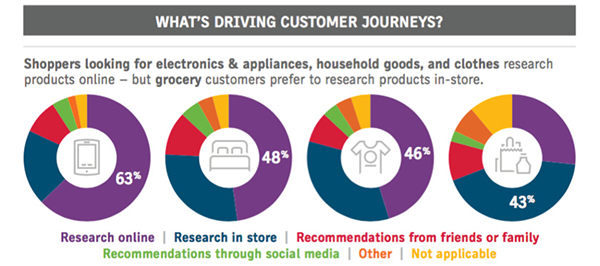Hello, Good Buy

Today’s retail environment is more complex than ever, given the rise of e-commerce and a rediscovery of the age-old truth that the customer is king. As retailers across the globe struggle with demands for both personalization and convenience, balanced with consumer skepticism on data privacy, JDA Software and Centiro explored consumer trends in key markets in its 2018 Global Consumer Survey.
Shopping in-store remains the most popular experience overall (preferred by 38 percent), although online options are preferred in some surveyed countries such as China, where online shopping via mobile/tablet (34 percent) is the preferred option. Regarding in-store shopping, global respondents say that having the right product in stock is the most important aspect of their shopping experience (34 percent), followed by having a variety of products to choose from (29 percent).
Regardless of where transactions ultimately occur, according to the survey, online is the first stop on the shopper journey for clothes (46 percent), home goods (48 percent) and electronics (63 percent) (see chart). Younger consumers (ages 18-34) are more likely than average to begin their shopping journeys with recommendations from friends or family; the proportion of those who start their purchase journeys with input from friends or family decreases among older consumers.
While global consumers continue to embrace new technology for both research and transactions, they are somewhat hesitant about how their personal data is being used. Overall, 75 percent of respondents say they’re concerned about their online and in-store shopping history, such as transaction history and online searches, being used to provide better, more-personalized service.
Globally, the majority of respondents who shop in physical retail stores have used some form of emerging technology while shopping, whether it’s mobile coupons or discounts (49 percent) or individual recognition and personalized service based on loyalty programs (26 percent). However, UK consumers who shop in-store are least likely to have tried new technology in their shopper journey, with 70 percent of UK respondents claiming they have not used any emerging technology in stores, while more than 90 percent of Chinese in-store shoppers say they have used emerging technology in-store.
The convenience factor of returning items to the store continues to be the primary driver for consumers. Forty-nine percent of global respondents have used Buy Online Return In-store (BORIS) service, with half saying they’ve returned items bought online to stores because it was easier or faster, or because they would get a refund or store credit faster than by mail.
Thirty-six percent of those who have used BORIS in the past 12 months chose this option because the item purchased online was not what they expected, while 27 percent say that they bought multiple sizes or options for convenience and returned what they didn’t want or need.
However, the ease of returns doesn’t apply just to retailers that offer brick-and-mortar return services. Eighty-one percent of those who shop online say that following a poor returns service from an online retailer, they were likely to switch to a different vendor for future purchases.
Sixty-nine percent of those who shop for products online have used a Buy Online Pick-up In-store (BOPIS) option. Respondents used BOPIS in the past 12 months to avoid home delivery charges (42 percent), get the product sooner than it would be shipped (36 percent) and for added convenience over home delivery (33 percent).
In addition, 66 percent of those who used a BOPIS service say they either frequently or sometimes make additional purchases while picking up items in-store, underscoring an opportunity for add-on sales.
